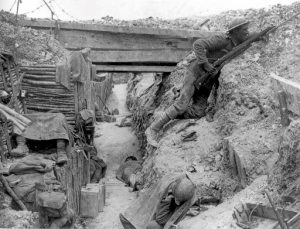8.5 Strategies for Getting Smaller
“In what industry or industries should our firm compete?” is the central question addressed by corporate-level strategy. In some cases, the answer that executives arrive at involves exiting one or more industries.
Retrenchment
In the early twentieth century, many military battles were fought in a series of parallel trenches. If an attacking army advanced enough to force a defending army to abandon a trench, the defenders would move back to the next trench and try to refortify their position. This small retreat was preferable to losing the battle entirely. Trench warfare inspired the business term retrenchment. Firms following a retrenchment strategy shrink one or more of their business units. Much like an army under attack, firms using this strategy hope to make just a small retreat rather than losing a battle for survival. It is also commonly referred to as “downsizing” or “right-sizing.”

Retrenchment is often accomplished through laying off employees. For example, South African grocery store chain Pick n Pay announced plans to release more than 3,000 of its estimated 36,000 workers. Just over a month earlier, South African officials had approved Walmart’s acquisition of a leading local retailer called Massmart. Rivalry in the South African grocery business seemed likely to become more fierce, and Pick n Pay executives needed to cut costs for their firm to remain competitive.
A Pick n Pay executive explained the layoffs by noting that “the decision was not taken lightly but was required to ensure the viability of the retail business and its employees into the future” (Chilwane, 2011). This is a common rationale for retrenchment—by shrinking the size of a firm, executives hope that the firm can survive as a profitable enterprise. Without becoming smaller and more cost effective, Pick n Pay and other firms that use retrenchment can risk total failure. This strategy was particularly evident during the COVID-19 pandemic of 2020. Many organizations shrank temporarily with hopes of surviving until the economy opened up again. Some did survive, and unfortunately, some did not.
Restructuring
Spin-offs occur when businesses create a new firm from a piece of their operations. Because some diversified firms are too complex for investors to understand, breaking them up can create wealth by resulting in greater stock market valuations. Spinning off a company also reduces management layers, which can lower costs and speed up decision making. Below we describe a variety of firms that were created as spin-offs.
| Examples of Spin Offs |
| There are 17 billion of Freescale Semiconductor’s chips in use around the world. The firm was spun-off from Motorola. |
| Toyota started in the car business, right? Wrong. The firm was spun-off in the 1930s from Toyoda Automatic Loom Works—a company that produced commercial weaving looms. |
| Delphi Automotive—an automotive parts company headquartered in Troy, Michigan—is a spin-off from General Motors. |
| Guidant Corporation—a spin-off from Eli Lilly—designs and manufacturers artificial pacemakers, defibrillators, stents, and other heart-helpful medical products. |
Executives sometimes decide that bolder moves than retrenchment are needed for their firms to be successful in the future. Divestment refers to selling off part of a firm’s operations. In some cases, divestment reverses a forward vertical integration strategy, such as when Ford sold Hertz. Divestment can also be used to reverse backward vertical integration. General Motors (GM), for example, turned a parts supplier called Delphi Automotive Systems Corporation from a GM subsidiary into an independent firm. This was done via a spin-off, which involves creating a new company whose stock is owned by investors (Table 8.4). GM stockholders received 0.69893 shares of Delphi for every share of stock they owned in GM. A stockholder who owned 100 shares of GM received 69 shares of the new company plus a small cash payment in lieu of a fractional share.
Divestment also serves as a means to undo diversification strategies. Divestment can be especially appealing to executives in charge of firms that have engaged in unrelated diversification. Investors often struggle to understand the complexity of diversified firms, and this can result in relatively poor performance by the stocks of such firms. This is known as a diversification discount. Executives sometimes attempt to unlock hidden shareholder value by breaking up diversified companies.
Sometimes diversified companies find themselves in a situation where, instead of synergy, they are experiencing increased inefficiency and increased costs. In this case, the value of the individual businesses are worth more separately than when part of the conglomerate. This can happen when an organization grows too large, with too many layers of management, and too top heavy. This situation is called a diversification discount. General Electric is a good example of this phenomenon. GE made everything from light bulbs, to washing machines, to jet engines, to CAT, scanners, to large power systems, and had engaged in operating a financial institution, GE Capital, that provided loans to companies. When the recession of 2008-2009 hit, GE Capital was left holding a lot of unpaid debt, and drove the GE stock price down. GE began to get out of the financing business, along with a number of its other business lines. It trimmed down to a much smaller organization that was not so complicated to manage in order to survive.

Fortune Brands provides another good example. Surprisingly, this company does not own Fortune magazine, but it has been involved in a diverse set of industries. The firm consisted of three businesses: spirits (including Jim Beam and Maker’s Mark), household goods (including Masterlock and Moen Faucets), and golf equipment (including Titleist clubs and balls as well as FootJoy shoes). Fortune Brand’s CEO announced a plan to separate the three businesses to “maximize long-term value for our shareholders and to create exciting opportunities within our businesses” (Dalal, et. al., 2011). Fortune Brands took the first step toward overcoming the diversification discount when it reached an agreement to sell its golf business to Fila. Later plans to spin off the home products business were announced.
Executives are sometimes forced to admit that the operations that they want to abandon have no value. If selling off part of a business is not possible, the best option may be liquidation. This involves simply shutting down portions of a firm’s operations, often at a tremendous financial loss. GM has done this by scrapping its Geo, Saturn, Oldsmobile, and Pontiac brands. Ford followed this approach by shutting down its Mercury brand. Such moves are painful because massive investments are written off, but becoming “leaner and meaner” may save a company from total ruin.
Key Takeaway
- Executives sometimes need to reduce the size of their firms to maximize the chances of success. This can involve fairly modest steps such as retrenchment or more profound restructuring strategies.
Exercises
- Should Disney consider using retrenchment or restructuring? Why or why not?
- Given how much information is readily available about companies, why do you think investors still struggle to analyze diversified companies?
References
Chilwane, L. (2011, July 7). Pick n pay to retrench. The New Age. http://www.thenewage.co.za/22462-1025-53-Pick_n_Pay_to_retrench.
Dala, M & Thomas, D. (2011, May 20). Fortune Brands to sell Titleist and FootJoy to S. Korea’s Fila. Reuters. https://www.reuters.com/article/fila-fortunebrands-idUSL4E7GK20A20110520.
Image Credits
Figure 8.10: Brooke, John Warwick. “A German trench occupied by British Soldiers near the Albert-Bapaume road at Ovillers-la-Boisselle, July 1916 during the Battle of the Somme.” Public Domain. Retrieved from https://en.wikipedia.org/wiki/File:Cheshire_Regiment_trench_Somme_1916.jpg.
Figure 8.11: Thegreenj. “A Master Lock brand padlock.” CC BY-SA 3.0. Cropped. Retrieved from https://commons.wikimedia.org/wiki/File:Masterpadlock.jpg.

